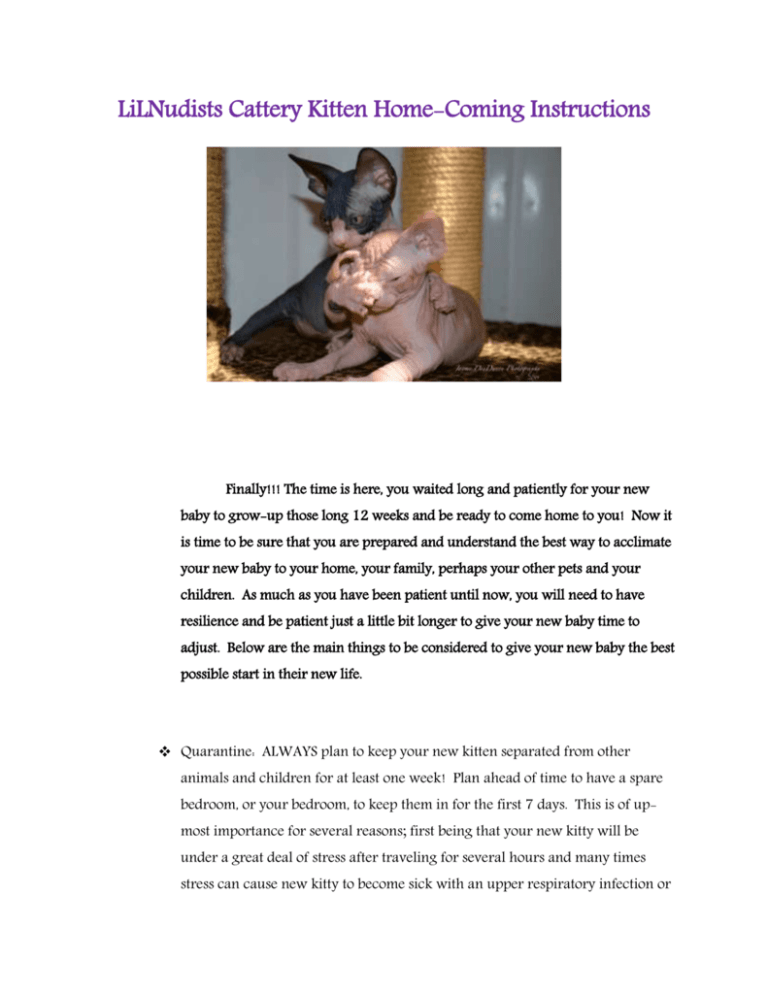Kitty Home-Coming
advertisement

LiLNudists Cattery Kitten Home-Coming Instructions Finally!!! The time is here, you waited long and patiently for your new baby to grow-up those long 12 weeks and be ready to come home to you! Now it is time to be sure that you are prepared and understand the best way to acclimate your new baby to your home, your family, perhaps your other pets and your children. As much as you have been patient until now, you will need to have resilience and be patient just a little bit longer to give your new baby time to adjust. Below are the main things to be considered to give your new baby the best possible start in their new life. Quarantine: ALWAYS plan to keep your new kitten separated from other animals and children for at least one week! Plan ahead of time to have a spare bedroom, or your bedroom, to keep them in for the first 7 days. This is of upmost importance for several reasons; first being that your new kitty will be under a great deal of stress after traveling for several hours and many times stress can cause new kitty to become sick with an upper respiratory infection or a gastrointestinal infection. Often times though these conditions and the viruses that cause them can lay dormant for 3 days before any signs of symptoms. So your new kitty may seem completely fine upon arrival and then on day 3 or 4 have a cold! This is why you must quarantine for a week, you do not want your other pets to become sick as well if this does happen, and unfortunately it is a fairy common occurrence. The second reason is because your new kitty will already be under a great deal of stress and other pets and children can exacerbate the current stress to them. Lastly, your new baby has been raised in one nursery room with only supervised trips out in the main part of the house, so your house will seem like a castle to your new kitty and they might not only get nervous at first, but also have difficulty remembering how to get back to the spot you put the litter boxes. Being in one room only with you will help them to feel more secure in the beginning and within a few days they will be more than ready to explore. Introduction: During the time your kitty is in quarantine, you can use this period to begin safely introducing your new kitty to the rest of your family. We recommend only letting small children visit for 5-10 minutes the first few days or only until if they become anxious and excited which could scare the kitty. After the first few days it is a good idea to take items of new kitty and let the other animals smell and vice versa; this could mean swapping blankets or toys ect. Just be cautious to be sure neither shows any signs of illness. Feeding time is a very good opportunity to begin socializing as well. While your kitty is still in quarantine period you will want to feed your kitten and your other cat/s next to either sides of the closed bedroom door. This way they have a chance to smell each other under the closed door safely and begin to associate the other cat with something good and positive that they both like FOOD! Along the same lines it is a great idea to you a sting toy that you can safely play with both cats through a closed door by putting it under the door to one side and then pulling it back through the other. If you have a patio with glass doors as well this is a wonderful way to safely let the cats see each other during the quarantine period without anyone being able to be hurt or catch a cold. Once through the quarantine period you are safe to let your new kitty meet the rest of the family! If you are still concerned or nervous about another cat or dog being aggressive to the new kitten there are ways you can let everyone meet and still be very safe for another period of a week or longer if needed to give more time for everyone to acclimate. The best way is for you to use a large carrier or metal crate that you will put the kitty in and allow the other kitty into the room so they can meet through the carrier/crate but still be safe. What you want to see happen is the other kitty come up to the crate door and smell and sniff, maybe even hiss a little or growl, but then walks away. Do not let them continue if the hissing and growling goes on for over a minute or they begin to try to fight between the crate door; if this happens separate them again and try again later that day or the next. Now you can continue this socialization each day but be sure to switch and have your house kitty in the crate the next time and the kitten outside to explore the house! You will want to help speed socialization during this process by giving treats to both, inside and outside of the crate right next to each other at the door, and also playing with them together through the crate with both will be wonderful too! Be sure to feed your house kitty and your new kitty in separate dishes to avoid food aggression/fear. Also if you have other cats you will need to increase the number and location of litter boxes you have for the house. It is advised by any veterinarian or professional animal behaviorist to have one additional litter box than you do cats in the household. This means that if you have three cats you should have four litter boxes available to them and in different areas of the house. This is the #1 cause of poor litter box behavior and inappropriate elimination is improper acclimation to the new household. Be certain to have the same type of litter box your new kitty has been used to, the same type of litter, one more boxes than you do cats, and placement of boxes in quiet low traffic areas. Think about it like this; would you be bit leery of sharing the same toilet with people you didn’t know; especially if they do not believe in flushing? Food and Supplements: It is also important to be sure you have the same food your kitten had been eating at home and ready for them when they arrive. We of course have a list of all that information and even offer you to purchase the food directly from us if you live locally to make it more convenient for you. Feed you kitten only this food for at least the first week, and then if you decide to switch your babies food do it very slowly over the course of a couple weeks by mixing the old food and the new food together gradually adding more of the new food until it is completely switched. This is important as to not cause diarrhea which can lead to dehydration and your new kitty feeling sick In addition, we STRONGLY advise you to use L-lysine powder and Forti Flora. L-lysine works to prevent out-breaks of kitty Rhinotracheitis, which is comparable to rhinovirus in humans which causes the common cold. It works to suppress the virus and improve immune function. This is extremely important during times in your new kitten’s life when they are under any stress for any reason, so very important for when they first arrive at your home. The daily dosage is ¼ tsp. for preventive maintenance. However the dose should be doubled, ½ tsp., for any stressful events like home-coming, people visiting, a new animal, a trip, family going away. The double dose should be continued for one week and then returned to ¼ tsp. daily every day thereafter. We hope this helps you be prepared and eliminates anxiety surrounding your new arrival. As long as you follow these steps and precautions all will go very smooth your new kitty will be happy and healthy for years to come. The HUGE key to all successful home-comings is that you reserve a lot of time and patience! Patience is a MUST your new kitty and other animals will need a full 3 week period before they are fully acclimated so be sure to be patient, patient and more patient! As always any questions just ASK! Copyright - April Arguin RDH, Founder of LiLNudists Cattery 2015







